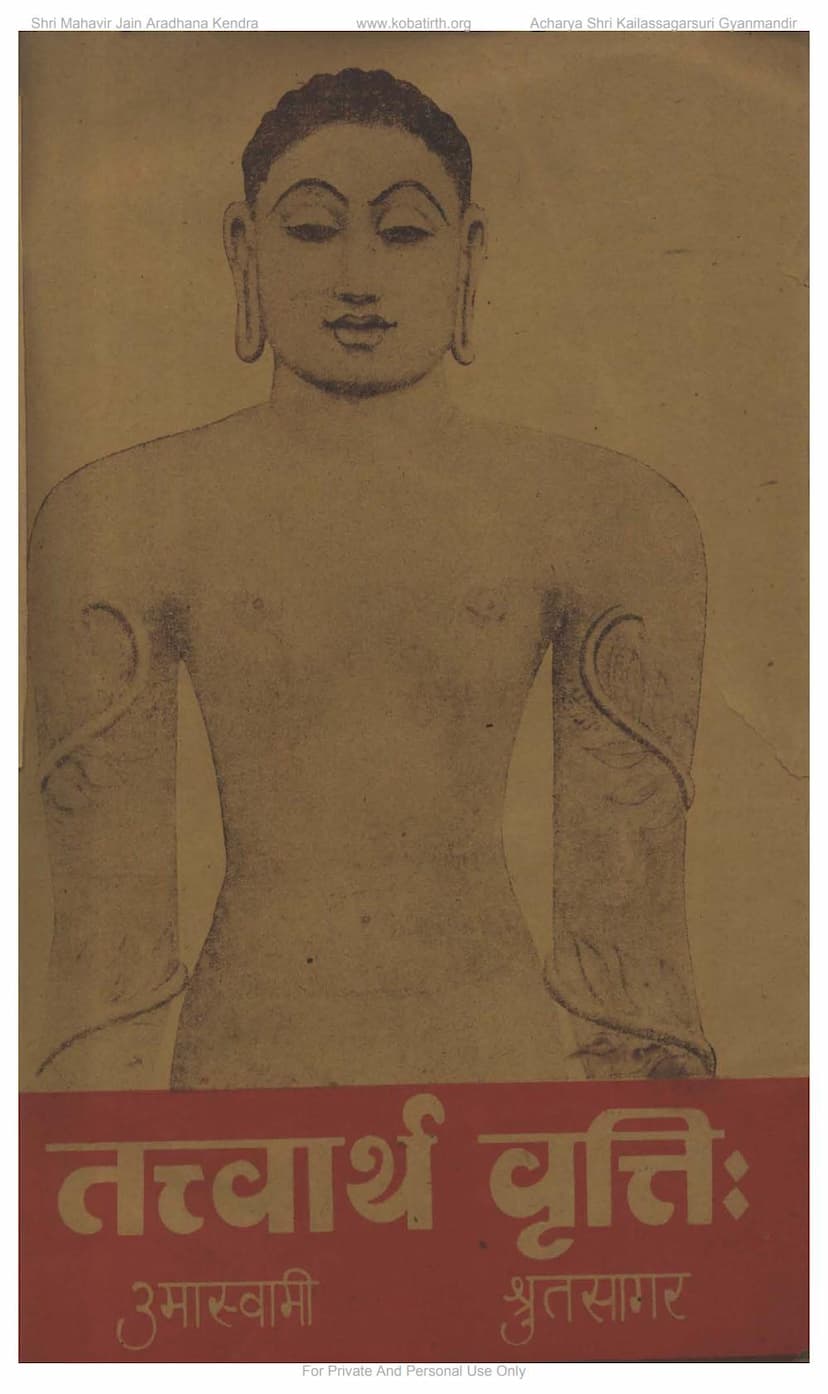Tattvartha Vrutti
Added to library: September 2, 2025

Summary
This document is a scanned image of the Tattvartha Vritti (Commentary on Tattvartha Sutra) authored by Shri Shrutasagar Suri, published by Bharatiya Gyanpith. It is part of the Jnana-Pitha Moorti Devi Jain Granthamala, Sanskrit Grantha No. 4. The book was first published in March 1949, with a print run of 600 copies. The edition is edited by Prof. Mahendra Kumar Jain and assisted by Udayachandra Jain.
The provided text contains the introduction (Prastavana) and Table of Contents (Anukram) for the book. Based on the text, here's a comprehensive summary of its content and scope:
Core Subject:
The book is a detailed commentary on the Tattvartha Sutra, a foundational text in Jain philosophy attributed to Umaswami. The commentary is by Shrutasagar Suri, a revered Jain scholar. The introduction emphasizes the profound and comprehensive nature of the Tattvartha Sutra, describing it as a "sacred text" and the "Gita, Bible, Quran" of Jainism.
Commentary's Approach and Scope:
- Comprehensive Explanation: The commentary aims to provide a thorough explanation of the Tattvartha Sutra, covering its profound philosophical principles, Jain cosmology, ethics, karma theory, and the path to liberation (moksha).
- Addressing Philosophical Debates: The introduction extensively discusses and critiques the philosophical views of contemporary thinkers of the time like Rahul Sankrityayan, S. Radhakrishnan, Baldev Upadhyaya, and others on various Jain concepts like Syadvada, Anekanta, and the nature of reality. It highlights the Jain perspective on these matters, often contrasting it with Buddhist and other philosophical schools.
- Detailed Analysis of Jain Principles:
- Tattvas (Realities): The book delves into the seven core Jain tattvas (Jiva, Ajiva, Asrava, Bandha, Samvara, Nirjara, Moksha) and their intricate details.
- Pramana, Nay, and Syadvada: It provides an in-depth explanation of Jain epistemology, including the concepts of valid means of knowledge (pramana), logical reasoning (naya), and the theory of conditional predication (syadvada), which is crucial to Jain philosophy's emphasis on manifold perspectives.
- Karma Theory: A significant portion is dedicated to explaining the complex Jain theory of karma, detailing its different types, causes (asrava), bondage (bandha), cessation (samvara), shedding (nirjara), and their profound impact on the soul's journey.
- Cosmology and Geography: The book includes detailed descriptions of the Jain universe, including its structure (lok), various realms (heavily referencing traditional Indian cosmology found in Vedic and Buddhist texts for comparison), the geography of Jambudvipa and other continents, mountains, rivers, heavens (svarga), and hells (naraka). The text notes similarities and differences with Vedic and Buddhist cosmologies.
- Soul (Jiva): It discusses the nature of the soul, its attributes, its bondage to matter (karma), its journey through different births, and its ultimate liberation. It contrasts the Jain view of the soul with concepts like the eternal soul in Vedic traditions and the anatma (non-soul) doctrine in Buddhism.
- Non-violence (Ahimsa): The commentary emphasizes the central role of ahimsa in Jainism, not just in action but also in thought and speech, as the foundation of the entire philosophy and path to moksha.
- The Path to Moksha: The core path to liberation is presented as the "Ratnatraya" – Right Faith (Samyak Darshan), Right Knowledge (Samyak Jnana), and Right Conduct (Samyak Charitra). The commentary details the nature of these three jewels and their role in achieving liberation.
- Ethics and Conduct: It outlines the vows (vratas) for both ascetics (monks) and laypeople (shravakas), including the five great vows (mahavratas) and the five lesser vows (anuvratas), along with their associated ethical principles and observances.
- Niyativada vs. Purushartha: A significant part of the introduction critiques the concept of niyativada (determinism/fatalism) prevalent in some contemporary philosophies, strongly advocating for the Jain emphasis on purushartha (human effort and free will) in shaping one's destiny and achieving liberation.
- Critique of External Rituals: The introduction and commentary seem to stress the internal purity and realization of the soul's true nature over mere external rituals or blind adherence to tradition. It advocates for "Samyak Darshan" of the soul itself, rather than merely observing external practices.
- Importance of "Samyak Darshan": The text places a strong emphasis on understanding the true meaning of "Samyak Darshan" (Right Faith/Perception), differentiating it from mere ritualism or blind adherence to ancient traditions. It advocates for critical inquiry and understanding based on logic and experience.
- Scholarly Apparatus: The commentary by Shrutasagar Suri is presented as highly scholarly, drawing upon a vast array of Jain and other Indian philosophical and literary works. The introduction lists numerous cited texts and authors, indicating a deep engagement with the tradition.
- Hindi Summary: The commentary also includes a "Hindi Sar" (Hindi Summary) of the Tattvartha Sutra, making the core teachings accessible to a wider audience.
- Critical Edition: The introduction highlights the use of multiple manuscript copies (palm-leaf and paper) in various libraries for the critical editing of the commentary, indicating a meticulous approach to textual accuracy.
Author and Publisher:
- Author of Commentary: Acharya Shri Shrutasagar Suri.
- Author of Sutra: Bhagavan Umaswami.
- Publisher: Bharatiya Jnanpith, Kashi.
- Granthamala: Jnana-Pitha Moorti Devi Jain Granthamala (founded in memory of Shri Moorti Devi by Seth Shanti Prasad Jain).
- Editors: Prof. Mahendra Kumar Jain (General Editor, Sanskrit Section) and Pt. Udayachandra Jain (Assistant).
Overall Significance:
The Tattvartha Vritti by Shrutasagar Suri is presented as a significant contribution to Jain literature, offering a detailed and critical exposition of foundational Jain principles. The introduction sets a scholarly tone, engaging with intellectual currents of its time and advocating for a reasoned understanding of Jain philosophy, moving beyond blind faith and mere ritual. The work aims to clarify complex philosophical and cosmological ideas, making the Tattvartha Sutra more accessible and its teachings relevant.